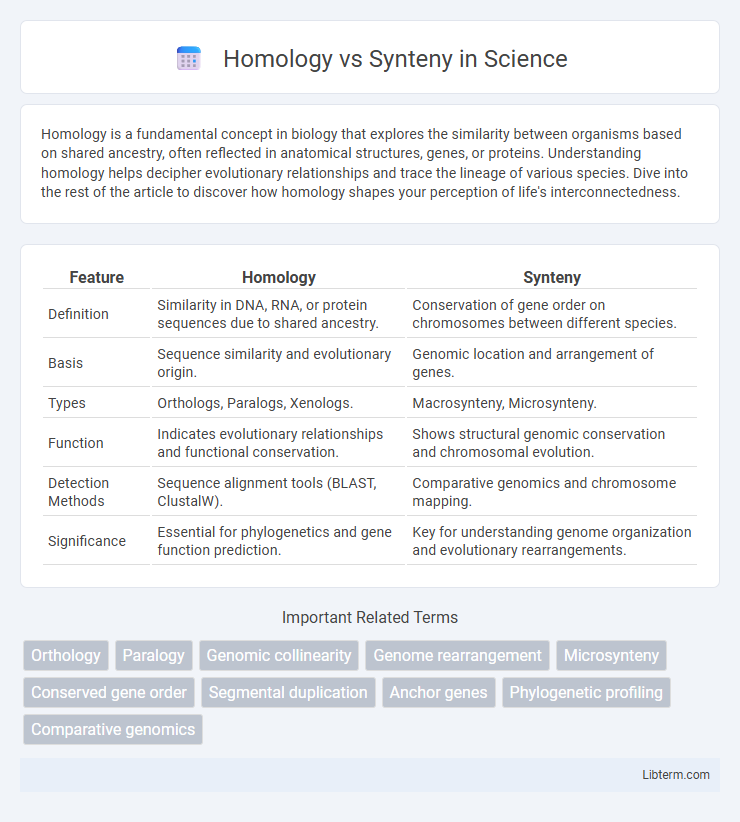Homology is a fundamental concept in biology that explores the similarity between organisms based on shared ancestry, often reflected in anatomical structures, genes, or proteins. Understanding homology helps decipher evolutionary relationships and trace the lineage of various species. Dive into the rest of the article to discover how homology shapes your perception of life's interconnectedness.
Table of Comparison
| Feature | Homology | Synteny |
|---|---|---|
| Definition | Similarity in DNA, RNA, or protein sequences due to shared ancestry. | Conservation of gene order on chromosomes between different species. |
| Basis | Sequence similarity and evolutionary origin. | Genomic location and arrangement of genes. |
| Types | Orthologs, Paralogs, Xenologs. | Macrosynteny, Microsynteny. |
| Function | Indicates evolutionary relationships and functional conservation. | Shows structural genomic conservation and chromosomal evolution. |
| Detection Methods | Sequence alignment tools (BLAST, ClustalW). | Comparative genomics and chromosome mapping. |
| Significance | Essential for phylogenetics and gene function prediction. | Key for understanding genome organization and evolutionary rearrangements. |
Introduction to Homology and Synteny
Homology refers to the evolutionary relationship between genes or proteins that share a common ancestral origin, indicated by sequence similarity and conserved function across species. Synteny describes the conserved order of genes on chromosomes between different species, reflecting shared genomic architecture despite evolutionary divergence. Understanding homology helps identify gene function and lineage, while synteny provides insights into chromosomal evolution and genome organization.
Defining Homology in Genomics
Homology in genomics refers to the existence of shared ancestry between genes or genomic regions across different species, indicated by sequence similarity due to common descent. Homologous genes can be classified into orthologs, which diverged after a speciation event, and paralogs, arising from gene duplication within a species. Understanding homology is crucial for tracing evolutionary relationships and predicting gene function based on conserved sequences.
Understanding Synteny: Concepts and Importance
Synteny refers to the conservation of blocks of genes on chromosomes across different species, reflecting ancestral genomic arrangements and assisting in tracing evolutionary relationships. Understanding synteny is crucial for identifying genomic rearrangements, gene order preservation, and functional genomics, making it a key tool in comparative genomics and evolutionary biology. Unlike homology, which focuses on gene sequence similarity due to shared ancestry, synteny emphasizes the physical co-localization of genes, providing a broader context for genome evolution studies.
Types of Homology: Orthologs vs Paralogs
Orthologs are genes in different species that evolved from a common ancestral gene through speciation, typically retaining similar functions, while paralogs arise from gene duplication events within the same genome and often diverge to acquire new functions. Homology describes these evolutionary relationships at the gene level, contrasting with synteny, which refers to the conserved order of genes on chromosomes across species. Understanding orthologs and paralogs is crucial for functional annotation and evolutionary studies in comparative genomics.
Synteny Blocks and Their Detection
Synteny blocks represent conserved regions of chromosomes across different species, crucial for understanding genome evolution and structural rearrangements. Detection methods for synteny blocks include comparative genomics tools like MCScanX and SynChro, which identify collinear gene pairs and preserve gene order and orientation. Advanced algorithms leverage sequence similarity, gene order conservation, and statistical models to accurately delineate synteny blocks, facilitating insights into evolutionary relationships and functional genomics.
Methods for Identifying Homologous Genes
Methods for identifying homologous genes include sequence alignment techniques such as BLAST and PSI-BLAST, which detect similarity based on nucleotide or amino acid sequences. Phylogenetic analysis reconstructs evolutionary relationships by comparing gene trees, helping distinguish orthologs from paralogs within gene families. Structural and functional annotations, combined with synteny analysis--examining conserved gene order across genomes--further validate homology by linking sequence similarity to evolutionary context.
Tools and Techniques for Synteny Analysis
Synteny analysis relies heavily on tools such as MCScanX, SyMAP, and SynChro to identify conserved genomic blocks across species, leveraging algorithms that detect collinear gene clusters. Comparative genomics platforms like CoGe and Ensembl also facilitate synteny visualization through interactive browsers and customizable pipelines. These techniques integrate gene annotation, sequence alignment, and chromosomal mapping to elucidate evolutionary relationships beyond simple homology.
Evolutionary Significance of Homology and Synteny
Homology indicates shared ancestry between genes or proteins, reflecting evolutionary relationships and providing essential insight into gene function conservation and divergence across species. Synteny, the preserved order of genes on chromosomes, reveals evolutionary events such as chromosomal rearrangements and helps trace lineage-specific genomic changes. Together, homology and synteny offer complementary evidence for reconstructing evolutionary history and understanding genome evolution patterns in diverse organisms.
Applications in Comparative Genomics
Homology identifies genes or proteins sharing a common evolutionary ancestry, essential for predicting gene function across species in comparative genomics. Synteny analyzes conserved gene order on chromosomes, enabling the detection of chromosomal rearrangements and evolutionary events across genomes. Together, homology and synteny provide complementary insights for reconstructing genome evolution and annotating genomes in comparative studies.
Key Differences Between Homology and Synteny
Homology refers to the similarity between genes or proteins due to shared ancestry, while synteny describes the conserved order of genes on chromosomes across different species. Homologous genes can be classified as orthologs or paralogs, indicating evolutionary relationships, whereas synteny emphasizes the preservation of genomic context and physical gene arrangement. Unlike homology, which focuses on sequence similarity, synteny highlights chromosomal organization, aiding in comparative genomics and evolutionary studies.
Homology Infographic

 libterm.com
libterm.com